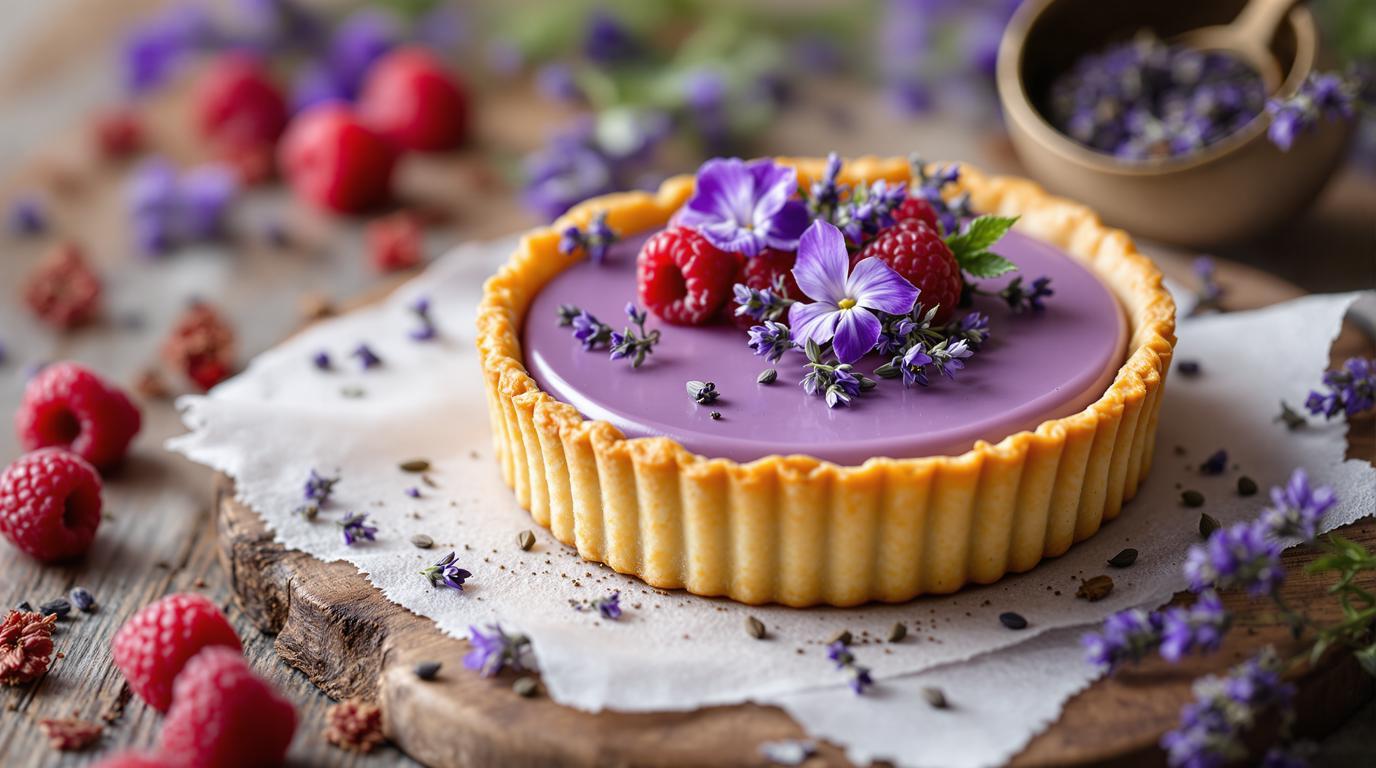There’s something almost magical about the marriage of bergamot-scented Earl Grey tea and delicate lavender. In my grandmother’s kitchen in Provence, she would infuse desserts with lavender from her garden, claiming it was “medicine for the soul.” Years later, while working at a patisserie in London, I discovered how beautifully these two flavors complement each other. Today, I’m sharing my Lavender Earl Grey Tart – a recipe that bridges French technique with British tea tradition, creating something truly special that’s become a signature in my own culinary repertoire.
The Story Behind Lavender Earl Grey Tart 📖
This elegant tart has its roots in traditional French patisserie but embraces the beloved British tea culture. The bergamot oil in Earl Grey tea adds citrus notes that perfectly balance lavender’s floral essence, preventing that dreaded “soap-like” quality that can happen when lavender is mishandled. The resulting dessert is sophisticated yet comforting – the kind that makes guests pause mid-bite to savor the complex flavors.
I’ve refined this recipe over decades, perfecting the delicate balance between tea and flower. The trick? Patience during the infusion process and restraint with the lavender. As my first mentor used to say, “With lavender, the difference between divine and disaster is just a pinch.” 🌿
Essential Ingredients 🧾
For the Earl Grey Shortcrust Pastry:
- 1½ cups (180g) all-purpose flour
- ½ cup (40g) powdered sugar
- ½ teaspoon salt
- 8 tablespoons (113g) unsalted butter, melted
- 1-2 Earl Grey tea bags (contents emptied) or 1 teaspoon loose leaf
For the Earl Grey-Lavender Custard:
- 2 cups (475ml) whole milk
- 2 tablespoons Earl Grey tea leaves
- 1 tablespoon dried culinary lavender buds
- 3 large egg yolks
- ½ cup (100g) granulated sugar
- 2 tablespoons unsalted butter
Step-by-Step Instructions 📝
1. Create the Earl Grey Pastry
- Grind your Earl Grey tea leaves to a fine powder using a mortar and pestle or spice grinder. This releases more flavor than simply emptying tea bags.
- In a medium bowl, whisk together flour, powdered sugar, salt, and ground tea.
- Pour in melted butter and mix until dough forms a cohesive ball. Don’t overwork it – tender pastry requires a gentle touch.
- Wrap in plastic and refrigerate for at least 1 hour. This rest period is non-negotiable – it prevents shrinkage during baking.
2. Blind Bake the Crust
- Preheat oven to 350°F (175°C).
- Press dough evenly into a 9-inch tart pan with removable bottom.
- Line with parchment and fill with pie weights or dried beans.
- Bake for 15 minutes, then remove weights and parchment.
- Return to oven for 10-12 minutes until edges are golden. Cool completely.
3. Create the Lavender-Earl Grey Custard
- In a saucepan, heat milk until just below simmer (tiny bubbles around the edge).
- Remove from heat, add tea leaves and lavender. Cover and steep for 10 minutes – no longer or bitterness will develop.
- Strain mixture through a fine-mesh sieve, pressing gently to extract flavors.
- In a clean saucepan, whisk egg yolks with sugar until pale.
- Gradually whisk in the infused milk, then return to medium-low heat.
- Cook, stirring constantly with a wooden spoon, until custard coats the back of the spoon (about 6-8 minutes).
- Immediately strain through a fine-mesh sieve into the cooled tart shell.
- Dot with butter and refrigerate for at least 3 hours until set.
Chef’s Note: Always strain your custard twice – once after infusion and again after cooking. This ensures the silkiest texture and removes any potential bits of cooked egg. This small extra step makes a world of difference in the final product.
Chef’s Secret Techniques 🤫
The key to this tart lies in temperature control. When cooking custard, keep the heat gentle – patience prevents curdling. I use the “figure-eight” stirring method, constantly moving the spoon in a figure-eight pattern to ensure even cooking. And if you don’t have culinary lavender, you can substitute 1/4 teaspoon of lavender extract, adding it at the end of the cooking process to preserve its delicate flavor.
To achieve professional bakery-level results, chill the filled tart thoroughly before serving. The contrast between the crisp, tea-infused crust and the silky, floral custard intensifies with proper chilling. For special occasions, I’ve been known to add a gossamer-thin layer of candied pistachios between the crust and custard – a technique borrowed from my days working with Italian pastry chefs.
Serving & Presentation Tips 🍽️
Serve this tart at room temperature – cold dulls the flavors, while too warm loses the custard’s structure. Before serving, dust lightly with confectioners’ sugar and garnish with a few fresh lavender buds or edible flowers. A complementary side is a small scoop of honey ice cream or a dollop of lightly sweetened whipped cream.
For an impressive dinner party finale, I like to serve slices with a tablespoon of champagne sabayon alongside. The acidity cuts through the richness and elevates the floral notes. If you’re going for a more rustic presentation, serve the tart on a wooden board with fresh berries scattered around – the tartness provides a wonderful contrast to the sweet custard.
This tart has graced the tables of my restaurants and family gatherings for years. It reminds us that sometimes the most rewarding flavors come from unexpected pairings. Much like my grandmother’s simple bread recipe, it proves that with attention to detail and respect for ingredients, even home bakers can create something truly extraordinary. When you slice into your creation, you’ll understand why this humble tart has become a treasured recipe in my collection. 💜
